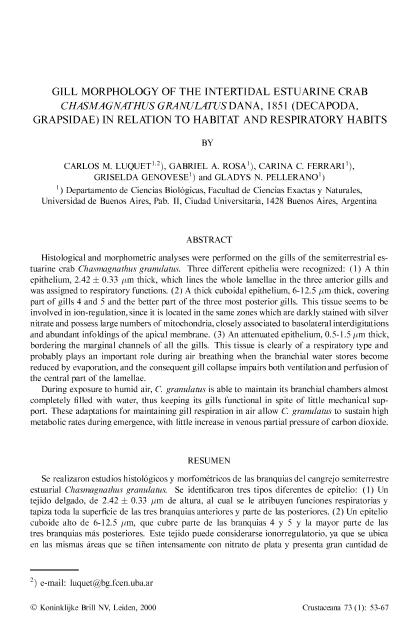Artículo
GILL MORPHOLOGY OF THE INTERTIDAL ESTUARINE CRAB CHASMAGNATHUS GRANULATUS DANA, 1851 (DECAPODA, GRAPSIDAE) IN RELATION TO HABITAT AND RESPIRATORY HABITS
Luquet, Carlos Marcelo ; Rosa, Gabriel A.; Ferrari, Carina Cintia
; Rosa, Gabriel A.; Ferrari, Carina Cintia ; Genovese, Griselda
; Genovese, Griselda ; Pellerano, Gladys Norma
; Pellerano, Gladys Norma
 ; Rosa, Gabriel A.; Ferrari, Carina Cintia
; Rosa, Gabriel A.; Ferrari, Carina Cintia ; Genovese, Griselda
; Genovese, Griselda ; Pellerano, Gladys Norma
; Pellerano, Gladys Norma
Fecha de publicación:
01/2000
Editorial:
Brill Academic Publishers
Revista:
Crustaceana
ISSN:
0011-216X
Idioma:
Inglés
Tipo de recurso:
Artículo publicado
Clasificación temática:
Resumen
Histological and morphometric analyses were performed on the gills of the semiterrestrial estuarine crab Chasmagnathus granulatus. Three different epithelia were recognized: (1) A thin epithelium, 2:42 ± 0:33 mum thick, which lines the whole lamellae in the three anterior gills and was assigned to respiratory functions. (2) A thick cuboidal epithelium, 6-12.5 mum thick, covering part of gills 4 and 5 and the better part of the three most posterior gills. This tissue seems to be involved in ion-regulation, since it is located in the same zones which are darkly stained with silver nitrate and possess large numbers of mitochondria, closely associated to basolateral interdigitations and abundant infoldings of the apical membrane. (3) An attenuated epithelium, 0.5-1.5 mum thick, bordering the marginal channels of all the gills. This tissue is clearly of a respiratory type and probably plays an important role during air breathing when the branchial water stores become reduced by evaporation, and the consequent gill collapse impairs both ventilation and perfusion of the central part of the lamellae. During exposure to humid air, C. granulatus is able to maintain its branchial chambers almost completely filled with water, thus keeping its gills functional in spite of little mechanical support. These adaptations for maintaining gill respiration in air allow C. granulatus to sustain high metabolic rates during emergence, with little increase in venous partial pressure of carbon dioxide.
Palabras clave:
Chasmagnatus Granulata
,
Respiratory System
,
Electron Microscopy
Archivos asociados
Licencia
Identificadores
Colecciones
Articulos(IIBBA)
Articulos de INST.DE INVEST.BIOQUIMICAS DE BS.AS(I)
Articulos de INST.DE INVEST.BIOQUIMICAS DE BS.AS(I)
Citación
Luquet, Carlos Marcelo; Rosa, Gabriel A.; Ferrari, Carina Cintia; Genovese, Griselda; Pellerano, Gladys Norma; GILL MORPHOLOGY OF THE INTERTIDAL ESTUARINE CRAB CHASMAGNATHUS GRANULATUS DANA, 1851 (DECAPODA, GRAPSIDAE) IN RELATION TO HABITAT AND RESPIRATORY HABITS; Brill Academic Publishers; Crustaceana; 73; 1; 1-2000; 53-67
Compartir
Altmétricas



